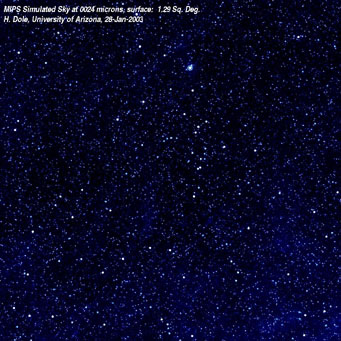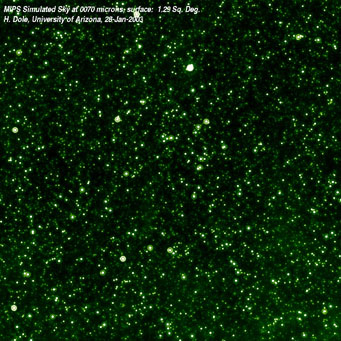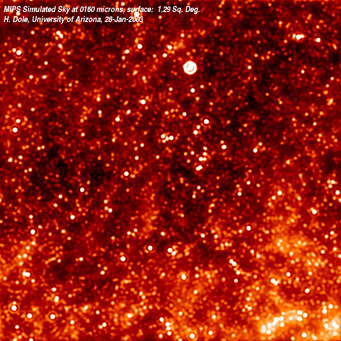![]()
Most cosmological surveys, including most of ours, use "brute force" imaging, where we just integrate for long times to get as deep as possible and find the faintest possible sources. The mostest of this type of SIRTF survey is the Legacy program Great Observatories Origins Deep Survey (GOODS). Click on the link to visit their web site.
 |
Only slightly less deep is our GTO program. Here are simulations by our own Herve Dole of what we expect to see at 24 microns (left) 70 microns (lower left) and 160 microns (lower right). The fields are about 1.3 degrees on a side, so the areas of our actual surveys (divided over a number of fields) will add up to a bit more. As you can see, we will detect many, many sources and will have to put in a lot of effort to figure out what they are to unravel the secrets they can tell about galaxy formation, assembly and evolution. |
 |
 |
In fact, we will detect so many sources at 70 and 160 microns that we will suffer from
a classic astronomical problem, the "confusion limit." This fancy term just
means that there are so many sources it will be hard to tell them apart - their signals
will be mixed up to an unavoidable extent because they are so close on the sky. Here is a
somewhat technical discussion of how we plan to deal with this limit.![]() Our deep surveys are in collaboration with the IRAC team, so
we will have detections of the sources at their four bands (3.6 - 8 microns) also.
Our deep surveys are in collaboration with the IRAC team, so
we will have detections of the sources at their four bands (3.6 - 8 microns) also.
By combining these data, we should be able to determine the redshifts of the galaxies. Since we have picked our deep field survey areas to have deep X-Ray data, we will also be able to sort out the galaxies with active nuclei (hence X-Ray emission) from the others. We will therefore be able to estimate the numbers of infrared galaxies powered by star formation or active nuclei at different redshifts, the basic data needed to understand the assembly and evolution of dust-enshrouded galaxies.
To form the next lower layer in the Tower of Babel, in collaboration with both IRAC and IRS we will survey a 9 square degree field to shallower limits than our "deep" fields. We have selected the Bootis field from the NOAO Deep Wide-Field Survey. We will use techniques similar to those discussed above to analyze these data.
The SIRTF Wide-area Infrared Extragalactic Survey (SWIRE) Legacy team is conducting a survey similar in depth to the GTO "shallow" survey. For details, see their web site.
More Reading
Read more about far infrared surveying here, or here.
 |
 |
|